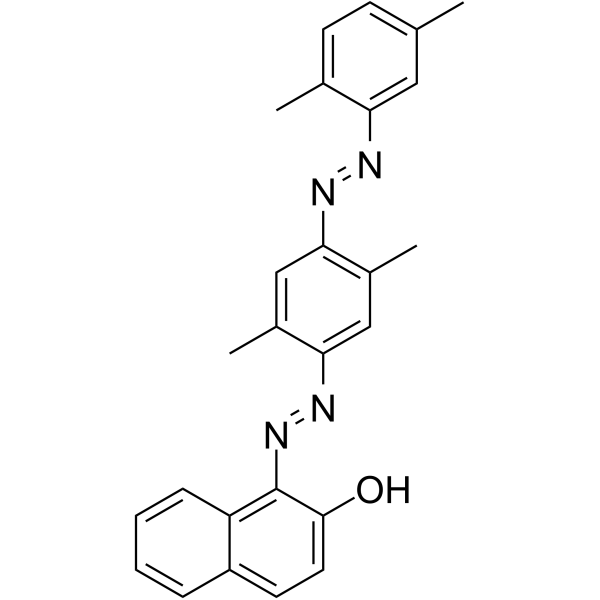Oil Red O

Oil Red O structure
|
Common Name | Oil Red O | ||
|---|---|---|---|---|
| CAS Number | 1320-06-5 | Molecular Weight | 408.495 | |
| Density | 1.2±0.1 g/cm3 | Boiling Point | 638.8±55.0 °C at 760 mmHg | |
| Molecular Formula | C26H24N4O | Melting Point | 120ºC | |
| MSDS | Chinese USA | Flash Point | 439.7±20.8 °C | |
| Symbol |


GHS02, GHS07 |
Signal Word | Danger | |
Use of Oil Red OOil Red O is a fat-soluble diazol dye, with a maximum absorption at 518 nm. Oil Red O stains neutral lipids and cholesteryl esters but not biological membranes. Oil Red O can be used for detecting and quantifying hepatic steatosis in mouse liver biopsies. Oil Red O staining efficiently helps to visualize the radical changes that occur in tissues as metabolic disease occurs and progresses[1]. |
| Name | 1-(2,5-dimethyl-4-(2,5-dimethylphenylazo)phenylazo)-2-naphthol |
|---|---|
| Synonym | More Synonyms |
| Description | Oil Red O is a fat-soluble diazol dye, with a maximum absorption at 518 nm. Oil Red O stains neutral lipids and cholesteryl esters but not biological membranes. Oil Red O can be used for detecting and quantifying hepatic steatosis in mouse liver biopsies. Oil Red O staining efficiently helps to visualize the radical changes that occur in tissues as metabolic disease occurs and progresses[1]. |
|---|---|
| Related Catalog | |
| References |
| Density | 1.2±0.1 g/cm3 |
|---|---|
| Boiling Point | 638.8±55.0 °C at 760 mmHg |
| Melting Point | 120ºC |
| Molecular Formula | C26H24N4O |
| Molecular Weight | 408.495 |
| Flash Point | 439.7±20.8 °C |
| Exact Mass | 408.195007 |
| PSA | 69.67000 |
| LogP | 7.58 |
| Vapour Pressure | 0.0±2.0 mmHg at 25°C |
| Index of Refraction | 1.631 |
| Storage condition | Store at RT. |
| Symbol |


GHS02, GHS07 |
|---|---|
| Signal Word | Danger |
| Hazard Statements | H225-H319-H336 |
| Precautionary Statements | P210-P261-P305 + P351 + P338 |
| Personal Protective Equipment | Eyeshields;Gloves;type N95 (US);type P1 (EN143) respirator filter |
| Hazard Codes | F,Xi |
| Risk Phrases | 36/37/38-67-36-11 |
| Safety Phrases | S24/25 |
| RIDADR | 1993.0 |
| WGK Germany | 3 |
| Hazard Class | 3.0 |
| HS Code | 32041900 |
| HS Code | 32041900 |
|---|
|
Controlled sumoylation of the mevalonate pathway enzyme HMGS-1 regulates metabolism during aging.
Proc. Natl. Acad. Sci. U. S. A. 111(37) , E3880-9, (2014) Many metabolic pathways are critically regulated during development and aging but little is known about the molecular mechanisms underlying this regulation. One key metabolic cascade in eukaryotes is ... |
|
|
Autophagy facilitates secretion and protects against degeneration of the Harderian gland.
Autophagy 11(2) , 298-313, (2015) The epithelial derived Harderian gland consists of 2 types of secretory cells. The more numerous type A cells are responsible for the secretion of lipid droplets, while type B cells produce dark granu... |
|
|
The role of lipid droplets and adipocytes in cancer. Raman imaging of cell cultures: MCF10A, MCF7, and MDA-MB-231 compared to adipocytes in cancerous human breast tissue.
Analyst 140(7) , 2224-35, (2015) We have studied live non-malignant (MCF10A), mildly malignant (MCF7) and malignant (MDA-MB-231) breast cancer cells and human breast cancer tissue. We demonstrate the first application of Raman imagin... |
| 2-Naphthalenol, 1-[(E)-2-[4-[(E)-2-(2,5-dimethylphenyl)diazenyl]-2,5-dimethylphenyl]diazenyl]- |
| 1-(2,5-Dimethyl-4-(2,5-dimethylphenylazo)phenylazo)-2-naphthol |
| Oil red O(C.1.26125) |
| EINECS 215-295-3 |
| MFCD00003898 |
| Solvent Red 27 Sudan Red 5B |
| Oil Red O |
| 1-[(E)-{4-[(E)-(2,5-Dimethylphenyl)diazenyl]-2,5-dimethylphenyl}diazenyl]-2-naphthol |
| 1-((4-((2,5-Dimethylphenyl)diazenyl)-2,5-dimethylphenyl)diazenyl)naphthalen-2-ol |

